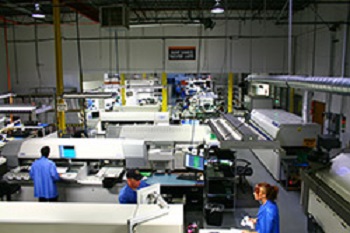
Speed and precision are factors every PCB assembler needs to consider when striving for the best competitive advantage. It’s the reason why customers choose to partner with contract assemblers, rather than assembling the boards themselves. The central driving force behind efficient PCB assembly is arguably technology automation; and four of the most important technology machines used by top assemblers are surface-mount printing presses, surface-mount pick and placement machines, surface-mount reflow ovens, and 3D X-Ray.
The prevalence of surface-mount technology is no coincidence, as this solution for assembling printed circuit board assemblies (PCBAs) permits the use of smaller components, thereby producing higher-circuit-density PCBs than with through-hole technology. Instead of using a wire lead to pass through holes on a PCB, components are specially made to have small planar leads that can be directly soldered onto the PCB surface, allowing a great deal of assembly automation.
Worth noting: PCB Assemblers such as Advanced Assembly attribute an assembly rate 87% faster than the industry average on account of machine-placed assembly services. With numbers like that, the technology is definitely worth taking a closer look.
Surface-Mount Printing
After the design schematics are verified and the assembly process begins, some PCB assembly companies use a stencil screen printer to apply a solder paste onto the solder pads of the PCB. The stencil printer can typically apply solder paste for components with a pitch (the distance between the centerline of one lead to the next) as small as 0.5 mm and use vision-control systems to ensure proper alignment.
Surface-Mount Placement
Once the pasting is completed, the PCBAs are placed in a surface-mount placement machine, otherwise known as a pick-and-place machine, or P&P. It is here that the components are placed in the wet solder paste. The P&P machine uses pneumatic suction cups attached to plotter-like devices to accurately mount the capacitor, resistors, integrated circuits, and other electronics onto the PCB. Not only do most advanced P&P machines allow components to be situated on both sides of a circuit board, but SMT-compatible components often are less expensive than their through-hole counterparts.
Reflow oven
The next step in the assembly process is to run the boards through a reflow soldering oven. During this phase, boards enter a preheat zone that gradually raises the temperature high enough to melt the soldering particles in the solder paste, and bond the component leads to the pads on the PCB. The conventional method of reflow involves hot air convection, or heating the air around the circuit board to melt the solder. An alternate approach is to use a vapor reflow oven, such as the Rehm Vapor Reflow Oven used by Advanced Assembly. Rather than heating the surrounding oxygen, the Rehm oven clears the oxygen from the chamber where the PCB is located and replaces it with the vapor of a chemical called Galden. This approach may prevents issues caused by solder-thieving, solder bridging, and insufficient solder on joints by applying an even, consistent heat; it’s also effective with any size components — a quality especially important when assembling a wide variety of boards.
3D BGA X-Ray Machine
3D BGA X-Ray machines are widely used by top assemblers for assessing the quality of a finished product. With the proliferation of ball grid arrays (BGAs), land grid arrays (LGAs), and bottom terminated components with exposed pads (QFNs), in circuit building, these machines have become essential tools-of-the-trade. These packages are integrated circuit packages with solder joints hidden on the bottom of the device. As a result, microscopes do not have a clear visibility of the solder joint, making real-time x-ray imaging the only possible method to thoroughly inspect the board and identify any defects.
The examples given above may play the most active role in the assembly process, but they are many other technologies involved. Additional equipment that may be used by assemblers include a programmable batch washer for cleansing the PCB of excess solder and flux, smart tweezers and multi-meters for verifying components, and de-panelizers / press-fit tools. Selecting an assembly partner that investing in the latest technology and equipment based on industry and customer trends is the best way to stay competitive.
Advertisement
Learn more about Advanced Assembly





